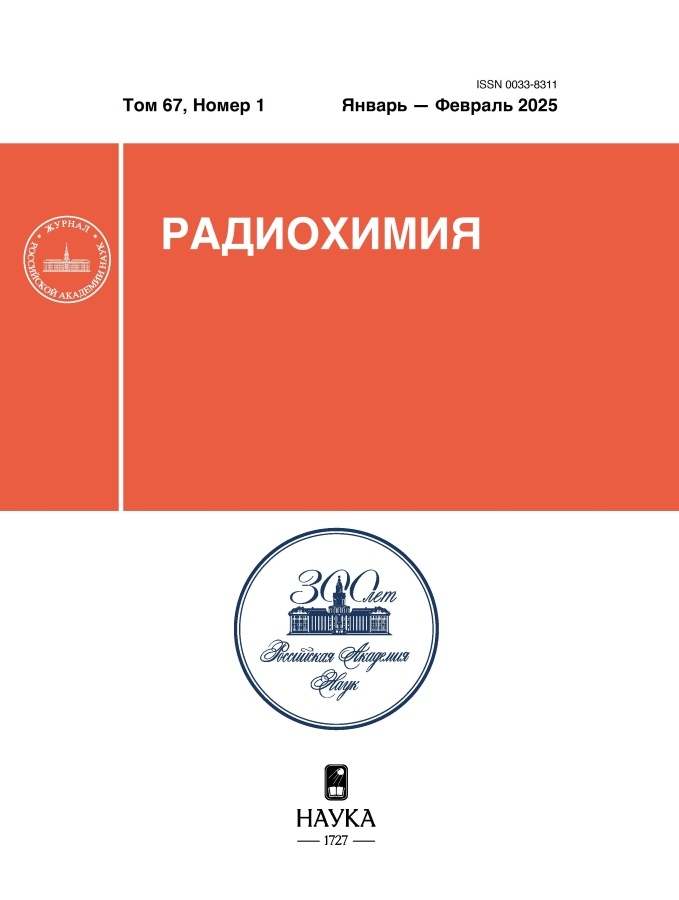Preparation of high-labeled graphene oxide by tritium thermal activation method for application in the betavoltaic cell of a nuclear battery
- Authors: Badun G.A.1, Bunyaev V.A.1,2, Chernysheva M.G.1
-
Affiliations:
- Moscow State University
- Vernadsky Institute of Geochemistry and Analytical Chemistry, Russian Academy of Sciences
- Issue: Vol 66, No 2 (2024)
- Pages: 165-170
- Section: Articles
- URL: https://ruspoj.com/0033-8311/article/view/661159
- DOI: https://doi.org/10.31857/S0033831124020074
- ID: 661159
Cite item
Abstract
Possibility of tritium introduction into graphene oxide (GO) by tritium thermal activation method was demonstrated. It has been established that, in order to obtain the highest possible specific radioactivity, thin films of GO with a thickness of 5.6 mg/m2 must be treated with tritium atoms. The experiment provided at 77 K showed a number of advantages. Under these conditions, the specific activity of [3H]GO of 2.6 Ci/mg was reached when calculated by the mass of the initial GO (0.7 Ci/mg if purified to remove the labile tritium). Specific energy release in [3H]GO with such specific activity is 22.3 W/kg, which is enough for its application as a component of an atomic battery.
Full Text
About the authors
G. A. Badun
Moscow State University
Author for correspondence.
Email: badunga@my.msu.ru
Faculty of Chemistry
Russian Federation, MoscowV. A. Bunyaev
Moscow State University; Vernadsky Institute of Geochemistry and Analytical Chemistry, Russian Academy of Sciences
Email: badunga@my.msu.ru
Faculty of Chemistry
Russian Federation, Moscow; MoscowM. G. Chernysheva
Moscow State University
Email: badunga@my.msu.ru
Faculty of Chemistry
Russian Federation, MoscowReferences
- Krasnov A.A., Legotin S.A. // Instrum. Exp. Tech. 2020. Vol. 63. P. 437–452.
- Wagner D.L., Novog D.R., Lapierre R.R. // J. Appl. Phys. 2020. Vol. 127. Article 244303.
- Zhou C., Zhang J., Wang X., Yang Y., Xu P., Li P. et al. // ECS J. Solid State Sci. Technol. 2021. Vol. 10. Article 027005.
- Ershova N.A., Krasnov A.A., Legotin S.A., Rogozev B.I., Murashev V.N. IOP Conf. Ser. Mater. Sci. Eng. YEAR? Vol. 950. Article 012007.
- Sun W., Kherani N.P., Hirschman K.D., Gadeken L.L., Fauchet P.M. // Adv. Mater. 2005. Vol. 17. P. 1230–1233.
- Chang Y., Chen C., Liu P., Zhang J. // Sensors Actuators A Phys. 2014. Vol. 215. P. 17–21.
- Bormashov V.S., Troschiev S.Y., Tarelkin S.A., Volkov A.P., Teteruk D.V., Golovanov A.V. et al. // Diam. Relat. Mater. 2018. Vol. 84. P. 41–47.
- Цветков Л.А., Цветков С.Л., Пустовалов А.А., Вербецкий В.Н., Баранов Н.Н., Мандругин А.А. // Радиохимия. 2022. Т. 64. С. 281–288.
- Кузнецов Р.А., Бобровская К.С., Белобров И.С., Тихончев М.Ю., Новиков С.Г., Жуков А.В. // Радиохимия. 2022. Т. 64. С. 289–296.
- Sosnin L.J., Suvorov I.A., Tcheltsov A.N., Rogozev B.I., Gudov V.I. // Nucl. Instrum. Meth. Phys. Res. A. 1993. Vol. 334. P. 43–44.
- Wu M., Wang S., Ou Y., Wang W. // Appl. Radiat. Isot. 2018. Vol. 142. P. 22–27.
- Li H., Liu Y., Hu R., Yang Y., Wang G., Zhong Z., Luo S. // Appl. Radiat. Isot. 2012. Vol. 70. P. 2559–2563.
- Lei Y., Yang Y., Liu Y., Li H., Wang G., Hu R. et al. // Appl. Radiat. Isot. 2014. Vol. 90. P. 165–169.
- He H., Klinowski J., Forster M., Lerf A. // Chem. Phys. Lett. 1998. Vol. 287. P. 53–56.
- Badun G.A., Chernysheva M.G., Grigorieva A.V., Eremina E.A., Egorov A.V. // Radiochim. Acta. 2016. Vol. 104. P. 593–599.
- Bunyaev V.A., Chernysheva M.G., Popov A.G., Grigorieva A.V., Badun G.A. // Fullerenes, Nanotub. Carbon Nanostruct. 2020. Vol. 28. P. 191–195.
- Amirmazlaghani M., Rajabi A., Pour-mohammadi Z., Sehat, A.A. // Superlattices Microstruct. 2020. Vol. 145. Article 106602.
- Вербецкий В.Н., Митрохин С.В., Бадун Г.А., Евлашин С.А., Тепанов А.А., Буняев В.А. // Материаловедение. 2020. Т. 11. С. 8–11.
- Khmelnitsky R.A., Evlashin S.A., Martovitsky V.P., Pastchenko P.V., Dagesian S.A., Alekseev A.A. et al. // Cryst. Growth Des. 2016. Vol. 16. P. 1420–1427.
- Бадун Г.А., Чернышева М.Г. // Радиохимия. 2023. Т. 65. С. 158–171.
- Mouhat F., Coudert F.X., Bocquet M.L. // Nat. Commun. 2020. Vol. 11. Article 1566.
- Feicht P., Eigler S. // Chem. Nano Mat. 2018. Vol. 4. P. 244–252.
- Буняев В.А. Матер. Междунар. молодежного науч. форума «Ломоносов-2021»: Тез. докл. М., 12–13 апреля 2021 г. М.: МАКС Пресс, 2021. С. 783.
- Lian B., De Luca S., You Y., Alwarappan S., Yoshimura M., Sahajwalla V. et al. // Chem. Sci. 2018. Vol. 9. P. 5106–5111.
- Тясто З.А., Михалина Е.В., Чернышева М.Г., Бадун Г.А. // Радиохимия. 2007. Т. 49. С. 163–165.
- Li X., Lu J., Zheng R., Wang Y., Xu X., Liu Y. // J. Phys. D. Appl. Phys. 2020. Vol. 53. P. 1–6.
Supplementary files















